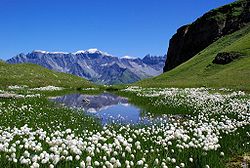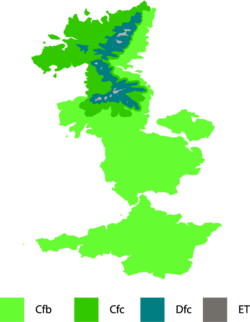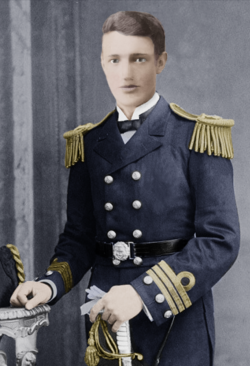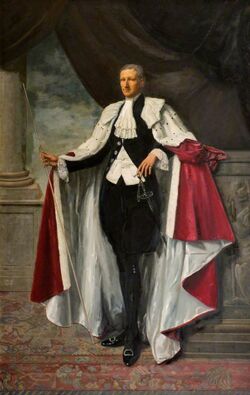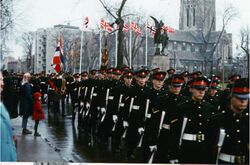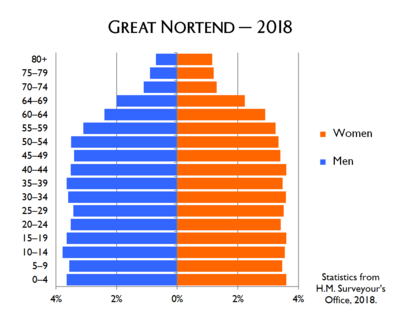Great Nortend
Kingdom of Nortend, Cardoby and Hambria Regnum Nortiæ Gardoliæ et Hambriæ | |
|---|---|
Motto:
| |
| Anthem: "Rex lætabitur in virtute tua" (The King shall joy) | |
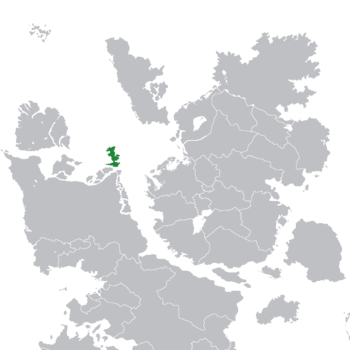 | |
| Capital | Lendert-with-Cadell |
| Recognised national languages | Erbonian English |
| Ethnic groups | 86% Arlethian 8% Ethlorekoz 5% Other |
| Government | Parliamentary Monarchy |
| King Alexander II | |
| Sir Spencer de Stornton | |
| Cardinal Sebastian Williams | |
| Legislature | The High Court of the Parliament |
| House of Lords | |
| Houses of Commonsa | |
| Area | |
• Metric | 100,851.4865 km2 (38,938.9766 sq mi) |
• Catherinian | 34,100 square Catherinian miles (158,000,000 Cath. acres) |
| Population | |
• 2019 estimate | 10,002,017 |
| GDP (PPP) | 2018 estimate |
• Total | £5,678 million ($681,097 million) |
• Per capita | £284 ($34,051) |
| GDP (nominal) | 2018 estimate |
• Total | £2,704 million ($324,332 million) |
• Per capita | £135 ($16,215) |
| Currency | Pound marten (GNP) |
| Time zone | UTC+0:30 (DMT) |
| Date format | dd-mm-yyyy |
| Driving side | left |
| Calling code | +37 |
| Internet TLD | |
| |
Great Nortend, formally known as the Kingdom of Nortend, Cardoby and Hambria, is an island nation at the north-eastern tip of the Mederano Peninsula in Astyria, comprising the three civil provinces of Nortend, Hambria and Cardoby. It shares no land borders with any other country; however, it has a sea border with Nikolia to the south across the Duke of Yarron's Sea. To the west is the Mederano Sea and to the east the Wet Water.
The main landmass of the Kingdom is formed of the islands of Greater and Lesser Erbonia. The country has a population of around 32 million inhabitants and still predominantly pastoral with large swathes of woodland and uncultivated land. The largest island in the Kingdom excluding the two main islands, is Cardoby, located off the coast of north-eastern Nortend. Great Nortend is considered to be mostly self-sustaining in terms of food production with net exports of corn.
Names
The formal name for the country is the „Kingdom of Nortend, Cardoby and Hambria”. The Kingdom's short name for diplomatic purposes is „Erbonia”, which also refers to the islands of the archipelago as a whole, is from the Latin „Erbonia”, a backformation of the longer „Insulæ Erbonicæ”, which literally means the „Erebic Islands”. „Great Nortend” is a common general term for the entire country, encompassing the entire kingdom and inclusive of all islands and isles separate from the two main landmasses.
„Nortend” is derived from the Erebic name „Nordenland”, meaning „land of the Nords”, the Nords being one of the major tribes that migrated from what is now Noordenstaat, along with the Cardes and Sexers. It thus could be said that both Noordenstaat and Nortend share the same name. The name „Nortend” is often used to refer to what is really Great Nortend. „Cardoby” is too derived from Erebic, meaning the „island of the Cardes”, as the island was the location of a Gardolian kingdom of the Cardes.
The name „Hoebrideland” derives from the Cothish name for the former Kingdom of Hambria „Hoembride” which means literally, „The kingdom (in the) mountain valleys”, a corruption of the Hoebric words for „mountain” (perme) and „valley” (bul) with the Cothish suffix for „kingdom” (rice). The modern Latin name for the province, „Hambria”, is a mediaeval Latinisation of Hoembride.
A person from Nortend is known as a „Nortchman”. „Nortish” is the main adjective relating to both Nortend and Great Nortend. The formal adjective for the kingdom, however, is „Erbonian”, as seen in the Sovereign's diplomatic style, His Erbonian Majesty and the names of more modern institutions such as the Royal Erbonian Airways and the Royal Erbonian Countryside Society. The gentilics of Hambria are „Hambrian” as an adjective and „Hoebridman” as a noun referring to persons. The adjectival form of Cardoby is „Gardolian” whilst a person from Cardoby is known as a „Cardishman”.
The use of the root word „Nort” in „Great Nortend” and „Nortish” to refer to the whole country is controversial in some academic spheres, as it subsumes Hoebrideland and Cardoby under the banner of „Nortend”. On the other hand, it is argued that the entire Erbonian population is Nortish insofar as the Hoes by the 16th century had effectively assimilated into the dominant Nortch Arlethic society, something which had occured even earlier with the Cardes and Sexers.
History
Antiquity and Arlethic Conquest
The Isles of Erbonia have been settled since antiquity by Ethlorek tribes, which spread throughout the island in mostly disparate populations including the Hoes to the north and the Erebes to the south of the Monmorians, the large mountain range which separate modern-day Hambria from Nortend. By 300 BC, a distinctive Erebic culture had emerged in the south, speaking varieties of Common Erebbonic, a North Ethlorek language. However, the Erebes peaked in unity in the 2nd century and by the 3rd century had become increasingly factionalised and weakend by infighting.
Lured by the fertile lands, the Arlethic Nords, Sexers and Cardes from what is now Noordenstaat arrived in Lesser and Middle Erbonia and established settlements. Originally, there were only sparse coastal settlements however in the late 3rd century, an increasing number of Arlethians arrived, displacing and slaughtering the Erebes in the Arlethic Conquest. Around eight major Arlethic kingdoms were formed in the country which were, roughly from north to south :— Bissex, Norsax, Cardoby, Barard, Oscardes, Lanorts, Suthnorts and Dunricia. Whilst in Middle Erbonia the Sexers and Cardes mixed, Lesser Erbonia became purely Nortish.
Early Middle Ages
Over the next few centuries, Lanort through marriage and conquest expanded, taking over Suthnort, Dunricia and Dorsex, forming the Kingdom of Nortend, speaking Low Erebic. Cardoby also took over Bissex and Norsax, forming the Lordship of Cardoby, speaking High Erebic. Barard and Almede fell to Nortend in the Barard-Nortish wars in the 6th century. Cardoby itself was conquered by Nortend in the late 7th century during the reign of Fredwin Longlobes; however, Norsax was lost to the Cothens under the reign of Oslac during a period of Cothen expansion. The Sexer Princes of the Cothens, now also controlling much of southern Hambria, were recognised as de facto suzerain by the northern Ethlorek Wignod and Tunel tribes by the early 8th century. They began to style themselves the King of Hoebride.
The Christian missionary, St. Laurence, arrived on the shores of Nortend in A. D. 744 during the reign of Egbert de Lanort by order of the Pope Zachary I to convert the heathens. After Egbert died in 753 after being mortally wounded by an arrow during battle with the Cothens, the Christian prince Hartmold de Mure took the Nortish throne after the War of the Interregnum. Through his reign and the consecutive reigns of Æthelfrey, Erwin and Edmund the Good, Christianity spread through the Kingdom. Under the rule of Edmund, who styled himself as King of Nortend and Lord of Cardoby, the Nortish armies conquered the remaining kingdom of Oscardes and reclaimed Norsax, until the entire country south of the Monmorians was united in one single Christian Kingdom of Nortend and Cardoby. Edmund the Good died in the Wars of the Monmorians, in 894, fighting the Cothens, and was recognised almost immediately as a martyr of the church.
-- Nicolian invasion? --
High Middle Ages

The House of Barmast claimed the throne of Nortend and Cardoby in 973 under Gerolph. The 11th century brought conflict to the northern regions of Nortend during the Peasant's Rebellion from 1034 to 1036 against increasingly high royal taxes. Jane ordered the execution of peasant villagers as punishment for their tax resistance; however, her barons and the Church refused to kill their tenants, as it would lead to their loss of their own income and reduce the value of their land. Jane relented, and reduced taxes.
In response to Jane's poor reputation and continued disquiet amongst the population, her successor Edward I in 1052 issued the Carta Erboniæ Libertatum which made several promises, including importantly a provision promising that future taxes would be approved by the King's barons. The Charter was affirmed by his successor, Richard I and successive kings until Stephen refused to so do. After he unilaterally raised taxes in 1122, he was assassinated by Matthew de Chepingstow. His successor, Richard III, was forced to swear an oath to abide by the Charter prior to his coronation.
Following the Battle of Rodchester, the House of Dester gained the throne in 1267. By the form of the Charter sworn to by Eltbold at his coronation in 1268, Eltbold 'voluntarily' disclaimed his power to create laws in certain privileged matters without the consent of the Curia Regis. Though he still had the power to create laws, and to issue writs, commissions &c. in other matters, this provision in the Charter severely restricted the independence of the King to create laws without the consent of his courtiers and powerful officers of state.
Frustrated in his attempts to pass statutes, Charles I increasingly began to summon all of his barons (rather than only the more powerful) and representatives of the clergy, commons and boroughs to his court, to override the increasingly stubborn and rebellious Curia Regis. As assent was obtained by majority vote of those present at Court, the increased number of commoners wishing to curry favour with the Crown allowed Charles to pass statutes without breaking his oath. Under this new raft of statutes, Nortend prospered financially. By the 13th century, Lendert had become a large port for trade, especially of wool, corn, linen and dyestuffs.
Late Middle Ages
The Dester period was marked by the Battle of Travlesea in 1455, when two factions of the House of Dester, lead by Peter III and Geoffrey respectively, claimed the throne after the passing of Charles II in a hunting accident. Peter's forces overcame Geoffrey's and Peter was crowned in 1456. However, the dynasty ended when Peter IV died in 1518 without any heirs. He had been highly unpopular owing to a series of failed military campaigns and lavish spending which had substantially drained the coffers of the Treasury and resulted in the necessary levying of excessive taxes by the Parliament.
The title of king thence passed to William II of the House of Anthord in 1519 in a transfer of power which involved numerous interested parties. The House of Anthord spoke the then minority language of Old English, owing to their [] roots. This influenced the shift of the common language from Erebian to Middle English. William began to appoint the senior or esteemed members of the Curia to his Privatum Consilium or 'Privy Council', to advise him privately on matters of state. They soon gained powers to act on the Sovereign's behalf. As Nortend increased the size of her army and navy, developing greater merchant shipping fleets, William needed to make a strategic marriage for his son, George. Thus, he arranged a marriage with XX of Aquitayne, who married the future King George I in 1522 in a lavish ceremony. As a dowry, YY of Aquitayne granted to William the islands of Hastica far off the coast of Ceria, becoming the first and only overseas possessions of the House of Anthord.
Union, Schism and Cleaving
In 1571, the future Charles III married the Princess of the Cothens, Clenancy de Cothen a Rhise, heir apparent to the Hambrian throne. After Charles III's early death in 1599, Clenancy became Queen of Hambria. Clenancy died in 1623 and her son, Alexander I, became King of Nortend and Cardoby and King of Hambria. Despite the personal union, Hambria continued to function separately from Nortend and Cardoby, with its own currency, weights and measures (the pound of Rhise or libra Cothenorum), social customs, languages (Cothish), legislature (the Curage of Rhise) and judicial system.
In 1614, Alexander I rejected the supremacy of the Pope in the Proclamation of Manfarnham, and established the Church of Nortend as an independent national church by the Statute of Limmes. In 1615, he by the Statute of Supremacy appointed himself the Supreme Governour of the Church Mundane. Though this “Great Schism” was a controversial move amongst the clergy, it was supported by the nobility and commoners suspicious of Rome. This act escalated tensions between the Exponential Empire and Nortend, leading to the Battle of Hastica of 1650 which led to the loss of Hastica.
After eighteen years of personal union, the Kingdom of Nortend and Cardoby and the Kingdom of Hambria were joined in the Statute of Cleaving of 1642 whereby Nortish law and bodies replaced or subsumed their Hambrian counterparts. Rebellion in Hambria ensued after the excessive taxes of 5 per cent on tithable revenues were levied by Lendert. The so-called Hambrian Rebellion culminated in the Battle of Borlockton in 1646; however, the Nortish Army subdued the peasants, and the rebellion ended with the signing of the Treaty of Rhise granting power to the old Hambrian Curage of Rhise, though sitting in Lendert, for the setting of taxes and other matters.
Modern times
It is commonly reckoned that modern times began with the accession of Mary in 1736. The Olnite Matter regarding her marriage to the Roman Catholic Earl of Scode in 1740 set in motion the origins of the modern political system. The marriage also brought about a dramatic improvement in Great Nortend's relations with the Exponential Empire which led to the return of Hastica in 1743. It also signalled the demise of the strongly Lutheran Protestant faction of Church of Nortend, which turned towards a more orthodox, albeit reformed, theology after the Akeeper Settlement.
The industrial revolution spread across Great Nortend slowly during the end of the 18th century and through the 19th, initially with the rapid building of canals and opening of coal mines followed by the rapid expansion of the railways from the mid-19th century. The various Combination Acts ended the historical system of feudal open strip-farming over much of Nortend and lowland Hambria by establishing conterminous fields under the control of a single tenant, thereby increasing efficiency and yields significantly. This reduced the number of people required to work the land from nearly 90 per cent of the population to less than two-thirds.
In response to the rapid changes brought on by industrialisation, foreign trade and modernity, various reactionary movements arose. The Romantic and Nationalist movements spread, advocating for a return to supposed feudal values of loyalty, hard work and faith over profit, convenience and materialism. This developed into the nationalist conservative movement in the 20th century, and continues to inform contemporary politics and social values to-day. The Coalition has been dominant in Erbonian politics with a majority in Parliament since the treasurership of Sir Henry de Foide.
Great Nortend continues to have a highly reactionary society, remaining lethargic in social and technological change since the early 20th century. The Erbonian oeconomy declined from its heights in the 19th century, and has only regained some of its losses in the last few decades. It uses the Catherinian system of weights and measures rather than the internationall widespread metric system. Despite some opposition, electricity is gaining ground in the country, although widely generated by specialised generator mills or as a side product of traditional water and wind mills. However, access to the Internet remains limited to official use, and the country is heavily reliant on the telegraphic, telephone and postal networks.
Geography
Erbonia is the general name for all of the islands and isles that make up the domestic realm or dominion of Great Nortend, excluding the colonial islands of St Parth and Hastica. Of the around twenty-three islands and isles thereof, the three major islands are Lesser Erbonia, Greater Erbonia, and Cardoby. The landmass, including all associated islands and isles, has a total area of approximately 190,542 square kilometres, 64,423 square Catherinian miles or 73,569 square Imperial miles. The country has no land borders with any other nation, but is separated from Nikolia by the Yarron Strait. It is located off the main land-mass of Teudallum, specifically the Mederano Peninsula, and is to the west of the northern end of the Putin Strait.
Approximately 35% of Erbonia's land is forested, of which 32% is managed woodland. Around 3·5% is built-up, with the rest being either cultivated or uncultivated land such as pastures, alpine meadows, hay meadows, wetlands, peat bogs and marshes. Erbonia's only substantially mountainous areas lie above the area known as the Medden lowlands in Greater Erbonia, including the Monmorians, Elps and Hambrian uplands. The Monmorians are a mountain chain spanning the width of Greater Erbonia, where they separate the civil province of Nortend from Hambria. They include the highest peak in Great Nortend, Gorblanhail, which is 8,792 ft (2,625 m) above sea level. The chain is part of the larger mountainous alpine region of the Elps. A smaller latitudinal hilly belt in the centre of Lower Erbonia is known as the Central Welds; however, it is mainly characterised by steeply rolling hills. The rest of the isles is mostly arable or forested lowlands, with areas of polderland in the south in Walecester and Swent.
In terms of geological resources, Erbonia has rich coal deposits, mainly in Lesser Erbonia and south-eastern Greater Erbonia. Lead, copper and tin are found in some regions too. Hambria possesses emerald-bearing rock in some regions of the Elps, whence Hambrian emeralds are mined.
Climate
The majority of Great Nortend has a cool-temperate oceanic climate (Köppen: Cfb), influenced by its geography as a collection of islands. The upland regions surrounding of the Monmorians and highlands north thereof have a subpolar oceanic climate (Köppen: Cfc) whilst the mountain ranges themselves have a subarctic climate (Köppen: Dfc) with polar tundras at their peaks (Köppen: ET). There is a significant temperature difference between the seasons, and snowfall is very common during winter, especially in Hambria. Much of Great Nortend is known for its habitual 'sun-showers', wherein light rain falls during an otherwise sunny day. There is an average monthly precipitation level of around two inches.
Flora
The isles of Erbonia have a wide range of vascular plant species. Both islands of Lesser and Greater Erbonia have a large number of native or historically introduced trees, including alder, apple, ash, beech, birch, box, cherry, chestnut, cyprus, elm, hawthorn, lime, maple, oak, pear, poplar, sycamore and yew. A number of these are important wood, coppicing or orchard species. The broad elm is the most common species of tree in Great Nortend, with a wide range spreading across the country below the Monmorians. It is the oak, however, which is considered the national tree.
The islands also has a wealth of wildflower species, widespread across the entire country. As most weedkillers, insecticides and pesticides are not legal in agriculture, species such as cornflowers, poppies, clover, daisies, tulips, foxgloves, violets, heather, gorse, buttercups, primroses, daffodils, anemones and orchids are common and widespread.
Politics
Great Nortend is a unitary semi-constitutional monarchy. The state is embodied in the Crown, which is represented by the Sovereign, who is currently Alexander II, King of Nortend and Hambria and Lord of Cardoby. The Sovereign by convention takes a less active rôle in policy-making, although he retains wide-ranging semi-absolute powers. The day-to-day government is headed by the Lord High Treasurer who is appointed by the King from the ranks of House of Lords, although commoners are often elevated to the House of Lords for the purpose of being appointing Lord Treasurer.[1] The office is equivalent to that of a Prime Minister. However, unlike in a Westminster Parliament, the Lord Treasurer is not always the leader of the largest party in the lower house, which since the 1950s has always been the Company of Scodeliers.
Executive
The Great Council, consisting of the King and his Counsellours, is the full Curia Regis of the Kingdom. However, in practice, executive power is mostly delegated to the smaller Privy Council and the Ministry which includes Cabinet ministers as well as the Utter Ministry. The functioning executive of Great Nortend is directed by the King and the Cabinet, the latter headed by the Lord High Treasurer, who as the head of H. M. Treasury and Exchequery, is primus inter pares and de facto head thereof.
Formally, the most senior ministers in Great Nortend are the seven Lord Officers of State. These form the ceremonial core of the Privy Council and Cabinet and are either hereditary, indicated with an asterisk in the list below, or appointments for life, excepting that of the Lord High Treasurer. They are, in order of precedence, the :—
- Lord High Steuard*: The head of the Royal Household. Also the speaker of the House of Lords and the senior-most judge under the King, deputising for the King in the Court of Counsellours. Held by The Earl of Barminster.
- Lord High Chancellour: The deputy speaker of the House of Lords and head of H. M. Chancery responsible for administration of the courts. Keeper of the Great Seal of the Realm. Administrator of the Church of Nortend. Held ex officio by the Lord Bishops of Chepingstow, who delegates to the Bishop of Laveshot most of his ecclesiastical and religious duties.
- Lord High Treasurer: The head of H. M. Treasury and Exchequery, and principal minister of the Government. Held by Sir Spencer de Stornton.
- Lord High Chamberlain*: Deputy in charge of the Royal Household, as well as responsible for organising ceremonial occasions such as state visits and weddings, and also serves as the King's representative in the House of Lords. Also serves as the Chief Justice of the Court of the Ermine Office. Held by The Earl of Godsucham.
- Lord High Admiral*: The Admiral of the Fleet, the ceremonial head of the Navy Royal. Held by The Duke of Derham.
- Lord High Constable*: Originally the commander of the Royal Army. Nowadays, the ceremonial King's Marischal thereof and also the Chief Justice of the Court of the Marischal and Constable. Held by The Margrave of Lasmere.
- Lord High Equerry: Originally responsible for the running of the Royal Mews. Now holds the office of Lord Master of Trade. Held by The Baron de Stanfield. He appoints a deputy, the Master of the Mews, to manage the day-to-day running of the Royal Mews, assisted by the Crown Equerries.
Other senior political Government cabinet-level positions are listed below :—
- Comptroller of the Exchequery: Deputy to the Lord High Treasurer, he is in charge of the Exchequer, that is, of collecting taxation, duties and levies, raising revenue for the Treasury. Held by Sir Martin Fitzgerald.
- King's Clerk: Minister in charge of home affairs, policing, national security, fire brigades, the constabularies and other domestic matters, who heads the Clerk's Office. Held by Sir Aaron Billings.
- Foreign Clerk: Minister in charge of foreign affairs and foreign diplomacy, who heads the Foreign Office. Held by the Rt. Hon. Sir George Drachington.
- War Clerk: Minister in charge of the War Office. Held by Frederic Hondle.
- Serjeant General at Law: Chief law advisor to the Crown, and also has control over most prosecutions by the Crown, and heads the Serjeant General's Office under the Chancery. Held by Sir Peter Finch.
- Postmaster General: Minister in charge of the running of and the head of the General Post Office under the Clerk's Office. Held by James Kinson.
- Master of the Board of Education: Responsible for schools, universities, educational standards and colleges who heads the Board of Education under the Clerk's Office. Held by Dr. Thomas Wolfuller.
- Lord Master of the Board of Agriculture: Responsible for management of agricultural practice, enclosure and surveys parishes by productivity. Held by The Lord Baker.
- Master of the Board of Health: Responsible for health services, hospitals, nursing and social care. Held by James Kinson.
Legislature
The Parliament, known formally as the High Court of the Parliament, is both the legislature as well as the highest court in Great Nortend. It is theoretically a tetracameral body, made up of the Sovereign and four houses of estate: the House of Knights, of the county knights sent from each county or “county equivalent district”; the House of Burgesses, of the burgesses sent from chartered borough towns and cities; the House of Clergy, of the clergymen elected by their peers to represent their dioceses; and the House of Lords, of the lords spiritual and temporal. However, in practice it is bicameral as the Houses of Knights and Burgesses sit together as the Houses of Commons, and the House of Clergy mostly only ceremonially. Additional members of Parliament include the Scholars of Commons, attached to the House of Burgesses, and the two MPs representing the Armed Forces in the House of Knights.
The Parliament meets at the Castle of the Lerdenstone, located between the Calbend, the River Hame, South Street and the Little Ditch Street within the Inner Ward of Cadell. Therein, the Houses of Commons sit in the Common Hall, a large chamber which dates from the 13th century and was originally the library of the Great Council, which became the present Library of Commons. It is distinctive having a blue ceiling, blue carpet and dark wood panelling and cabinetry with ornate plasterwork. The House of Lords meanwhile meets in the Great Chapel, a larger, more decorative chamber officially named the Chapel of St. Giles, with a scarlet or sanguine and gold colour tone with rich mahogany panelling and woodwork. The House of Clergy meet in the Chapter House of St. Giles, a semi-circular stone room. It is also the location of where the chapter of the College of St Giles meet.
Legislative and judicial bills are presented to both houses for debate and voting, and must be assented to by a majority in the Houses of Commons and the House of Lords before they are presented to the Sovereign for his Assentus Regis, or Royal Assent.
Administrative divisions
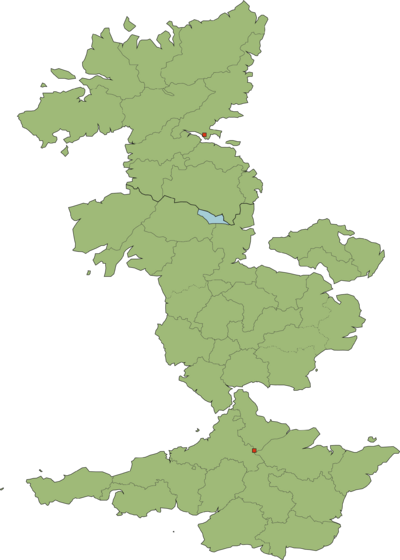
Northannering
Southannering
Eastannering
Midannering
Allells
Cranshire
Wainsey
Great Nortend is split into four civil provinces, being the Province of Nortend, the Province of Hambria, the Lordship of Cardoby and the County of Hastica. These are administrative regions and should not to be confused with the ecclesiastical provinces.
Each province, except for Hastica, is divided up into a varying number of counties, which are known as duchies in Cardoby and as marches on the border between Nortend and Hambria, owing to their status as counties palatine where a duke and marquess hold power. Other current counties palatine include Sulthey and County Yeartey wherein the Archbishop of Sulthey and the Bishop of St Cleaves hold certain powers. The Province of the County of Hastica is comprised only of the County of Hastica.
The three counties of Larkshire, Teyshire and Enley are known as the 'Close Counties' as they enclose and fully surround Lendert-with-Cadell. Lendert-with-Cadell itself is a sui generis area exempt from any county by Royal warrant. The Greater Lendert area, however, is often considered a de facto county.
Each county has a King's Lieutenant appointed, in Hastica known as the Viceroy-Governour, who as viceroy represents the King in his constitutional rôle. Therefore, the Lieutenant in theory commands the county militia and regiments, issues writs in the King's name, promulgates proclamations, prosecutes crimes, dispenses the King's justice and manages the county gaols, constabulary and prisons. He is assisted by a Sheriff who has main responsibility for the Lieutenant's judicial functions.
Counties in the Province of Nortend
| County | Abbreviation | County Town | Additional information |
|---|---|---|---|
| Aceshire | AX | Acingham | From Auscardescir, from the ancient Kingdom of Oscards. Largest county by area. Split into four Annerings. |
| Almeshire | AM | Metthews | From Almedescir, from the ancient Kingdom of Almede. |
| Barard | BR | Bailmorden | Final remnants of the ancient Kingdom of Barard. |
| Barminstershire | BA | Barminster | Shired lands in the ancint Kingdom of Suthnorts. |
| Bentshire | BE | Abeningham | From Bendnætscir, apparently meaning “Bound Net Shire”. As with Swent, Sweartnæt, what “Net” refers to is unknown. |
| Dunhamshire | DE | Dunham | From Dunenhamscir, meaning “Shire of the estate of the Duns”. |
| Eamshire | EA | Eamsford | From Ausalmedescir, meaning East Almedeshire, likely influenced by the name of the River Eams, from another root. |
| Enley | EN | Sulhampton | From Elnenege, meaning “Isle of Eln”, with metathesis. |
| Essingfordshire | ES | Essingford | Shired land in the ancient Kingdom of Suthnorts. |
| Fawnshire | FW | Faunslaughter | From Feaneslahtreowenscir, meaning “Shire of Feane's sloe tree”. |
| Gortland | GO | Elmstone | From Gortenland, named after the River Gort. |
| Harvickshire | HV | Harvick | From Hearwewicscir, meaning “Harrow Wick Shire”. |
| Herstlow | HE | Tretford | From Hyrstenlogland, meaning the “Hurst Lows”. |
| Heymeadshire | HY | Heymead | From Heahalmedescir, meaning “High Almedeshire”. Split into Northeymeadshire and Southeymeadshire. |
| Igoxeter | IG | Igoxeter | From Igganceaster, meaning fortified town on the Igg. |
| Larkshire | LA | Limmes | From Limesricscir, meaning “Shire in the Limmes Region”. |
| Leaton | LE | Downthorp | From Leaten, meaning “People of Leat”, either from the town named Leat or the Leat people from whence the town is named. |
| Merst | ME | Mast | From Mairicesæt, meaning “Inhabitants of the kingdom of the Mai”. |
| Narland | NA | Chepingstow | From Nærland, meaning “Near Land”; possible referring to its proximity with the Kingdom of Nortend in Dorsex. |
| Norsax (Loweshire) | NO | Lowesk | From Norþseaxan, the ancient Kingdom of Norsax. |
| Poltland | PO | Polton | From Poltesland, meaning “Land of the Polts”. |
| Redwickshire | RC | Redwick | Shired land in the ancient Kingdom of Bissex. |
| Seffet | SF | Nailbridge | Unknown etymology. |
| Sulthey | SU | Sulthey | from Sulþesege, meaning “Isle of the Sulths”. |
| Suthrepourdeland | SP | Bellingford | From Suþernubreoteland, meaning “Land of the Southern Road” likely referring to the ancient Ritway. |
| Swent | SW | Mooping | From Sweartnæt, apparently meaning “Swart Net”. As with Bentshire, Bendnætscir, what “Net” refers to is unknown. Split into 4 Fathings. |
| Walecestershire | WA | Walecester | From Walceasterscir, meaning “Shire of the fortified town of the Wals”. In the ancient Kingdom of Dunricia. |
| Towshire | TO | Tow | From Togscir, meaning “Shire of Tow”. In the ancient Kingdom of Suthnorts. |
Duchies in the Province of Cardoby
| Duchy | Abbreviation | Duchy Seat | Additional information |
|---|---|---|---|
| County Allells | AL | Staithway | |
| County Cardenbridge | CB | Cardenbridge | |
| Mure | MU | Onlingham |
Counties in the Province of Hambria
| County | Abbreviation | County Town | Additional information |
|---|---|---|---|
| Bissex (Cranshire) | BI | Crandale | From Biseaxan. |
| Cothen-Wainsey | CW | Rhise | From Wæganiscege, meaning the “Isle of the Way”. |
| Eastlord | EL | Fivewells | |
| Despenshire (Longant) | LG | Stadell | |
| Esxshire | EX | Dreymond | |
| Ganningshire | GG | Ganning | |
| Westmarch | MR | Marcaster | |
| Minnerland | MN | Hexmeadbay | |
| Rhightonshire | RH | King's Rhighton | |
| Rocklehamshire | RK | Rockleham | |
| Tolland | TL | Tollsea |
Law and Justice
The law of Great Nortend is founded upon a mixture of customary law, chamber law and statute law, and administered by semi-feudal “sessions” courts as well as royal “chamber” courts. Judges are appointed by the Crown to serve at its pleasure. The Erbonian legal system differentiates between criminal law, common or civil law, admiralty law, martial law and ecclesiastical or canon law.
Military
The Armed Forces of Great Nortend is split into two branches, being the Royal Army and Navy Royal, administered by the War Office. There is no standalone air force in Great Nortend; however, the Air Division of the Navy Royal operates more or less independently of the Sea Divisions, simply as a practical matter.
The manpower of the Armed Forces is provided mainly by conscription by Muster Service where most Erbonian male subjects at the age of 18 are required to serve in either the Royal Army or Navy Royal if they do not enlist voluntarily. Muster Service involves three months of initial training and then posting within the country or abroad for nine months, with both military and labour duties.
Mustermen are usually assigned to a regiment of a corps of the Royal Army according to their parish, with all men from a given parish being conscripted together. The Navy does accept a limited number of mustermen with links to the naval or air professions. University students may train as and be commissioned as an officer during their degree. After their year of full-time Muster Service, mustermen are required to serve in the Home Service for another eight years before full discharge.
Œconomy
The œconomy of Great Nortend is heavily agrarian, which provides the livelihood for around half of the population, and localised, with a domestic semi-regulated market œconomy favouring isolationist mercantilism. The workforce is almost evenly split into thirds, with one third of the workforce employed in each of the primary, secondary and tertiary sectors.
Agriculture is somewhat developed helped by generally fertile soils, a temperate climate and plentiful rainfall which provides for excellent cropping for numerous small mixed farms. Great Nortend grows a wide variety of produce, and is mostly self-sufficient in terms of food.
The local œconomies in Great Nortend are mostly centred around the county and hundred, especially the market towns established under charter. Weekly or fortnightly markets held in these towns form the backbone of local agricultural œconomies along with the commercial sector of tradesmen and merchants. More locally, parochial rates raised from the populace are used to further the parish's infrastructure, services and development.
Œconomic growth in the manufacturing and service sectors is minimal, owing to isolationist policies and low levels of imports. The Government's policy is to levy high tariffs on incoming goods whilst levying lower tariffs on exported goods, which are mainly raw materials. Imports are mainly of iron ore, steel, copper and sand, as well as petroleum fuels and pharmaceuticals. Another growing focus is on tourism, which is becoming increasingly popular owing to the scenic natural landscapes the Erbonian countryside offers, as well as historical cities, towns and villages.
Gross domestic product
The nominal gross domestic product in the 2017-2018 tax year (same as the civil year) was around £2,704 million in nominal terms, and in purchase power parity terms around £5,678. The nominal GDP is broken down into £1,350 million in private household consumption, £500 million in private investment, £700 million in government spending, £314 million in exports and minus £160 million in imports.
The GDP per capita for the 20 million subjects is around £135 or approximately 16,125 US dollars although in PPP terms £284 or $34,051.
Infrastructure
Demographics
| Rank | Borough | Population | Shire |
|---|---|---|---|
| 1 | Greater Lendert | 2,132,000 | Greater Lendert |
| 2 | Rhise | 563,000 | Ganningshire |
| 3 | Faunslaughter | 423,000 | Faunshire |
| 4 | Limmes | 372,000 | Larkshire |
| 5 | Polton | 181,000 | Poltland |
| 6 | Southeymead | 155,600 | Southeymeadshire |
| 7 | Mooping | 135,900 | Teyshire |
| 8 | Tretford | 125,000 | Herstlow |
| 9 | Walecester | 122,200 | Walecestershire |
| 10 | Eamsford | 120,000 | Eamshire |
| 11 | Durmen-on-Sea | 120,000 | Durmenshire |
| 12 | Essingford | 107,400 | Essingfordshire |
| 13 | Sulhampton | 104,400 | Enley |
| 14 | Gibbingham | 102,900 | Southannering |
| 15 | Downwich | 100,700 | Leaton |
As of the census survey taken in 2018, the estimated population of Great Nortend is 20,002,017, a mere 0·3 per cent increase from 2015. Approximately 92 per cent of the population is Arlethic.
Official Government policy as to generational replacement, taken in the 1980s to ensure national stability under the Steady State Policy, aims for a 0 per cent growth rate. Thus, the Government recommends a maximum of three children per family, although there is no prohibition on more. The crude birth rate is approximately 18·11 births per 1000 people, equivalent to just over the replacement rate of 2·11 births per woman.
The vast majority of the population, over 65 per cent thereof, live outside of towns and cities, and over 40 per cent are engaged directly in the agricultural industry. The largest city is Lendert-with-Cadell, along with its surrounding urbanised region, having a population of 4·33 million people.
Unemployment of working-age able-bodied men of the lower and middle classes is low, at around 1·04 per cent. Average annual income of the lower and middle classes is in the region of £200 in the lower end and £500 in the higher end.
Greater mobility through cheap railway travel have been tempered by complicated feudal and tenure restrictions on the transfer and conveyancing of property leading to less of the rise of cities and large towns than in other countries.
Language
The predominant language spoken in Great Nortend is English, which is the de facto national language. Over 95 per cent of the population hold English as their mother tongue, with less than 5 per cent claiming some proficiency with other languages.
The English used in Great Nortend is known as Erbonian English and slowly became widespread after the rise of the House of Anthord to the throne in the 16th century. Even nowadays, Erebian is spoken by people in the provinces of Cardoby and Hambria, as well as the shires of County Yeartey, Igoddal and Towshire in Nortend. Erebian, which like English is an Athlethic language, is to an extent mutually intelligible with English. Its vocabulary is a base of Arlethic with a large number of Latin words interposed to a far greater extent than in English, retaining in many cases forms of the Latinate declensions and conjugations.
Court Latin is another important language in Great Nortend, being the official written language of law and the Curia Regis. As such, all official statutes, writs and decrees are in Latin, though the oral language is English. When an official written text is to be read out, such as for a proclamation, an English translation, known as the „teller copy” is provided and read from. Latin is almost never spoken, except in Court in certain set phrases or in scholarly settings.
Women
Great Nortend is a heavily patriarchial society. It is often criticised abroad for maintaining traditional male and female roles in society where women are considered to have their responsibilities in “Children, Chambers and Church”. As such, there is no female representation in most Erbonian professional or official institutions, which are de facto or de jure male only.
Religion
Religion in Great Nortend as of 2017.
The Church of Nortend is the established state church of Great Nortend following a denomination of Christianity known as Cardicanism. It is consequently the largest church in Great Nortend, with over 90 per cent of Erbonian subjects in communion at least nominally with it. The state church enjoys special privileges in Great Nortend, and being a Cardican is a prerequisite for many public occupations and offices. The Sovereign of Great Nortend is by law the Supreme Governour Mundane of the Church and titled the Vicar of Christ.
Other religions in Great Nortend are quite minor, and include to an extent other Protestant denominations, Judaism and Roman Catholicism and Judaism. Atheism or irreligiosity is extremely low, and is estimated to afflict less than 2 per cent of the population. There is discrimination against other religions both in law and socially. For example, those of other religions cannot hold public worship services except in specially licensed buildings, of which only one may be founded in any city or town, such as at the Great Synanogue in Lendert-with-Cadell.
Great Nortend prohibits the practice of certain religions under the Prohibitions Act.[2] These have included "Mohammedanism” (Islam) and Scientology, which have been deemed 'heretical cults'. Recent changes in the law in 2019 have made the practice of Mohammendanism permissible in certain cases.[3]
Education
Education in Great Nortend is divided into four stages :— infant (2–6), junior (6–10), middle (10–14) and senior (14–18). Junior and middle schooling are compulsory and universal for all children.[4] The schooling system is split between state and independent schools. Education through tutelage, known as private education, is permitted but rare.
Primary education
Primary education begins at the age of six and ends at the age of ten. The year levels in most schools are termed Lower or Bottom Junior, Second Junior, Third Junior and Upper or Top Junior respectively, corresponding to Year Two to Year Five in another countries.
The National Curriculum issued by the Board of Schooling includes studies in mathematics, English, history, geography, art and music, with introduction to Latin by Third Junior. In all state schools and in most independent schools, attendance at chapel is compulsory at least thrice a week, usually on Mondays, Wednesdays and Fridays, and is taken by the local parson or a school chaplain. Religious instruction occurs usually during chapel services. Organised sports and games are also considered an important part of primary education.
Secondary education
Secondary education begins with middle schooling typically at the age of ten in what is known as First Form. Thence, pupils progress to the Second Form, and then to the Lower and Upper Sixth Forms. Thereafter, pupils at independent schools may progress to senior schooling, in the Fourth Form, the Fifth Form and the Lower and Upper Sixth Forms.
The national curriculum for middle and senior schooling includes more advanced subjects such as algebra, trigonometry, calculus, ancient history, literary exegesis, rhetoric, theology &c. whilst continuing studies in music, art, Latin and French. Boys are be required to join the Cadet Corps during the First Form. At the end of the Second Form, pupils choose their supplementary subjects for the General Examinations, which are held at the end of the Upper Third Form. Those continuing in senior schooling will study for the Exhibition Examinations, held at the end of the Upper Sixth Form.
Tertiary education
The tertiary education sector is made up of sundry and varied providers, including the three ancient universities, various teaching and practical colleges, apprenticeships and informal on-the-job training.
Culture
Cuisine
The cuisine of Great Nortend is regional and intimately connected with the local land. “High cookery” is the form of Erbonian cuisine perfected by the Compagnie of Cooks, which is mostly an elaboration and refinement of traditional regional dishes.
Overall, there tends to be an emphasis on meats over the vegetable, with the focus of most meals being on one or more meats or fish with vegetables used to enhance or complement. The most common meats are beef, pork, mutton or lamb, and chicken, in order of popularity. Nearly the entirety of most animals are used as a component of some dish. Fish and seafood is very common given the widespread observation of fast days. Traditional cooking methods include roasting, baking, braising, stewing, boiling and frying, often with the use of fragrant vegetables, herbs and spices. Preservation techniques are also part to the Erbonian cookery. Sausages, hams, puddings, pies and potted meats are particularly popular.
Games and Sports
Games and sports are distinguished in Great Nortend principally by their nature. A „game” is commonly defined as an activity played for competitive amusement, whereas a „sport” is an activity practised per se. Many sportsmen are similarly good players of games, and vice versa.
Games
Games in Great Nortend include home-grown games as well as international games such as football and cricket.
The two most popular team games in Great Nortend are stinning and cricket. The former is a form of football and similar somewhat to rugby union or Australian rules, played with two teams on a round, oval-shaped turfed pitch known as the green with goal-posts at either end, split into three sections longitudinally. Cricket is played in Great Nortend in accordance with the Laws of Cricket as promulgated by the Royal Causildon Club, which manages both stinning and cricket in Great Nortend. Traditionally, stinning is played in the winter and cricket in the summer on the same green, by the same team, both games having 11-a-side teams.
Other popular team games include hockey, whelts and rounders, as well as other competitive games such as (lawn) bowls and tennis.
Sports
There is a rich history of various sports being practised in Great Nortend, including athletics, swimming, rowing, fencing, hunting and shooting. Deer, boar and fox hunting with hounds is a traditional formal sport, whilst shooting is a common week-end pasttime for the upper classes. Horse riding is popular as well, intimately connected with the widespread use of horses in everyday life. The alpine regions in the Monmorians are well-suited to alpine skiing, known in the country as sleighing, during the winter season.
The Nortish decathlon combines ten common sports into a single programme, and is fairly popular in Great Nortend.
References
- ↑ Cf. Sir Henry de Foide, Sir Benjamin de Davies, Sir Spencer de Stornton, & al.
- ↑ Prohibitions Act, 13 Cath. II.
- ↑ Prohibitions Act Amendment Act.
- ↑ Schooling Act.
This page is written in Erbonian English, which has its own spelling conventions (colour, travelled, centre, realise, instal, sobre, shew, artefact), and some terms that are used in it may be different or absent from other varieties of English. |





